|
|
|
Sort Order |
|
|
|
Items / Page
|
|
|
|
|
|
|
| Srl | Item |
| 1 |
ID:
112482
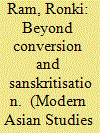

|
|
|
|
|
| Publication |
2012.
|
| Summary/Abstract |
Given different socio-economic structures, and acute landlessness among the Dalits of East Punjab, the agendas of conversion to neo-Buddhism and sanskritisation, the two most popular Dalit social mobility models in India, have failed to strike a cord among the Dalits in this border state of northwest India. But that does not imply that Dalits of Punjab have failed in improving their social status. On the contrary, they have been very vocal in their assertions for social justice and dignity, and pressing for a due share in the local structures of power; a clear indication of a significant surge of Dalit social mobility in Punjab. The question that still remains largely unexplored, however, relates to the patterns of Dalit social mobility in Punjab that have emerged independently of the agendas of conversion to neo-Buddhism and sanskritisation. The study aims to map out the contours of an emerging alternative Dalit agenda in Punjab, which is conspicuous by its absence in existing Dalit studies, and examines its catalytic role in enhancing the legitimacy and effectiveness of increasingly visible Dalit social mobility in the state. The paper concludes by visualising the possibility of an articulation and assertion of a similar alternative Dalit agenda through highly contentious democratic politics in other parts of India, where the archetypical agendas of conversion and sanskritisation have either failed to deliver social justice and dignity or could not simply appeal to the local Dalit population.
|
|
|
|
|
|
|
|
|
|
|
|
|
|
|
|
| 2 |
ID:
112484
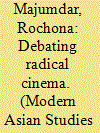

|
|
|
|
|
| Publication |
2012.
|
| Summary/Abstract |
This paper offers a history of the creation and development of film societies in India from 1947 to 1980. Members of the film society movement consisted of important Indian film directors such as Satyajit Ray, Ritwik Ghatak, Shyam Benegal, Basu Chatterji, Mani Kaul, G. Aravindan, Kumar Shahani, Adoor Gopalkrishnan, and Mrinal Sen, as well as film enthusiasts, numbering about 100,000 by 1980. The movement, confined though it was to members who considered themselves film aficionados, was propelled by debates similar to those that animated left-oriented cultural movements which originated in late colonial India, namely, the Progressive Writers Association in 1936, and the Indian People's Theatre Association in 1942. By looking at the film society movement as an early and sustained attempt at civil-social organization in postcolonial India, this paper highlights the two distinct definitions of 'good cinema'-from an aesthetically sophisticated product to a radical political text-that were debated during the time of the movement.
|
|
|
|
|
|
|
|
|
|
|
|
|
|
|
|
| 3 |
ID:
112483


|
|
|
|
|
| Publication |
2012.
|
| Summary/Abstract |
Colonial transformation of the relations of production contextualized the cultural articulation of a new set of values, prejudices, and tastes for the Bengali Hindu middle class. These cultural values, together with the political and economic conditions of colonialism, formed the habitus of this class. This paper tries to understand this self-fashioning by the middle class through their construction of a 'Bengali' cuisine. A distinct enthusiasm for new gastronomic possibilities defined this cuisine, and yet, at the same time, it possessed important elements of continuity from pre-colonial times, evidenced especially in the reinstitution of caste-based norms of gastronomy. The resultant cuisine was cosmopolitan yet still Bengali.
|
|
|
|
|
|
|
|
|
|
|
|
|
|
|
|
| 4 |
ID:
112481
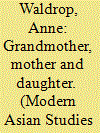

|
|
|
|
|
| Publication |
2012.
|
| Summary/Abstract |
Covering one hundred years, this paper recounts the life stories of three generations of middle-class women of the New Delhi-based Kapoor family. By taking the methodological view that individuals born approximately at the same time, within the same class segment, and at the same cultural place will be shaped by the same historical structures so that their lives to some extent are synchronized into a gendered, generational experience, these three life stories are viewed as voices that reflect their respective generational class segments. In view of this, the paper uses the three life stories to discuss changes in women's agency within the urban, educated, upper middle-class. Agency is here understood as control over resources, and it is argued that in order to understand changes in women's agency, one should take into account the impact of both social, economic structures and cultural ideologies. When analysing the three life stories, the overall finding is that the granddaughter has had more control over her own life than her mother and grandmother. However, by acknowledging that cultural ideologies and social economic structures are not always synchronized, a nuanced and many-dimensional picture of twists and turns in these middle-class women's degree and type of agency over time emerges.
|
|
|
|
|
|
|
|
|
|
|
|
|
|
|
|
| 5 |
ID:
112479
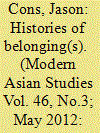

|
|
|
|
|
| Publication |
2012.
|
| Summary/Abstract |
This paper offers a history of belonging in Dahagram, a sovereign Bangladeshi enclave situated within India but close to the India-Bangladesh border. I recount Dahagram's post-Partition history, focusing particularly on the long and localized struggles between 1974 and 1992 to open the Tin Bigha Corridor, a land bridge through Indian territory that links Dahagram to the Bangladeshi mainland. Drawing on the memories and experiences of residents, I examine Dahagram's past(s) as narratives of postcolonial belonging: to fragmented conceptions of state and nation, to surrounding areas, and to the enclave itself. I focus on the overlapping tensions between national and local struggles to 'claim' Dahagram as Bangladeshi or Indian territory, and uneven processes of political inclusion within and around the enclaves and within the Bangladeshi State. I use 'belonging' as a double-entendre, as these tensions are all intimately linked to possession of land/territory, goods, and access to markets. The notion of belonging(s) helps to illuminate Dahagram's historical and contemporary cultural politics and political-economy, as well as its articulations with broader events in postcolonial South Asia. Yet, belonging is also an analytic for understanding how history is remembered and articulated as a claim to territory, rights, and membership in unstable places.
|
|
|
|
|
|
|
|
|
|
|
|
|
|
|
|
| 6 |
ID:
112480


|
|
|
|
|
| Publication |
2012.
|
| Summary/Abstract |
Recent economic changes in India have coincided with a dramatic change in the concept of a 'middle class' in the south Indian city of Madurai. Whereas previous sets of class identities were overwhelmingly dichotomous (for example, the rich and the poor, or the 'big people' and 'those who have nothing'), the middle class has now become a highly elaborated component of local class structures and identities. It is also a contested category; moreover, its indigenous boundaries differ from those most often used by scholars, marketers, or policy-makers. Drawing from research over the past decade, this paper examines local definitions of 'middleness' and the moralized meanings ascribed to it. Whilst being 'in the middle' is a source of pride and pleasure, connoting both achievement and enhanced self-control, it is simultaneously a source of great tension, bringing anxiety over the critical and damaging scrutiny of onlookers. For each positive aspect of a middle-class identity that emphasizes security and stability, there is a negative ramification or consequence that highlights the precariousness and potential instability of middle-class life. In exploring each of these aspects, I pay attention to the explicitly performative features of class identities. I conclude by considering the epistemological and experiential insights we gain into the construction of emergent class categories by focusing on self-ascribed identities and their performance.
|
|
|
|
|
|
|
|
|
|
|
|
|
|
|
|
| 7 |
ID:
112478
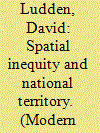

|
|
|
|
|
| Publication |
2012.
|
| Summary/Abstract |
In 1905, Viceroy Nathaniel Curzon applied well-worn principles of imperial order to reorganize northeastern regions of British India, bringing the entire Meghna-Brahmaputra river basin into one new administrative territory: the province of Eastern Bengal and Assam. He thereby launched modern territorial politics in South Asia by provoking an expansive and ultimately victorious nationalist agitation to unify Bengal and protect India's territorial integrity. This movement and its economic programme (swadeshi) expressed Indian nationalist opposition to imperial inequity. It established a permanent spatial frame for Indian national thought. It also expressed and naturalized spatial inequity inside India, which was increasing at the time under economic globalization. Spatial inequities in the political economy of uneven development have animated territorial politics in South Asia ever since. A century later, another acceleration of globalization is again increasing spatial inequity, again destabilizing territorial order, as nationalists naturalize spatial inequity in national territory and conflicts erupt from the experience of living in disadvantaged places. Remapping 1905 in the long twentieth century which connects these two periods of globalization, spanning eras of empire and nation, reveals spatial dynamics of modernity concealed by national maps and brings to light a transnational history of spatial inequity shared by Bangladesh and Northeast India.
|
|
|
|
|
|
|
|
|
|
|
|
|
|
|
|
|
|
|
|
|